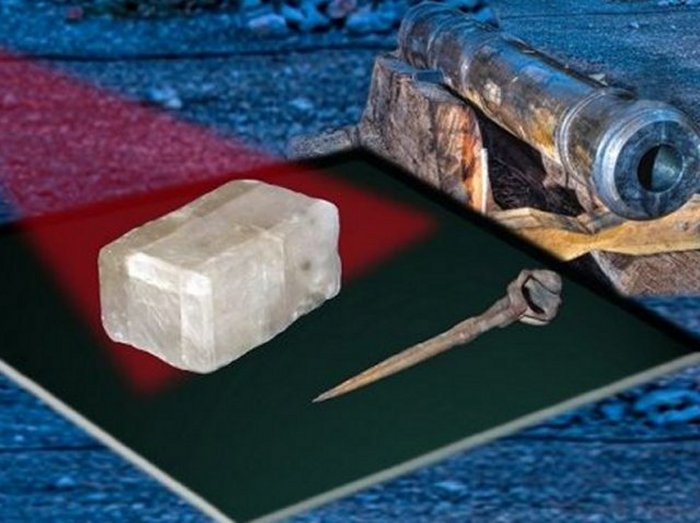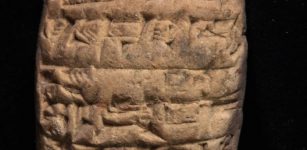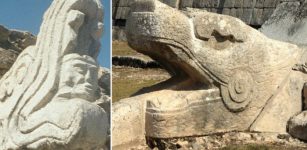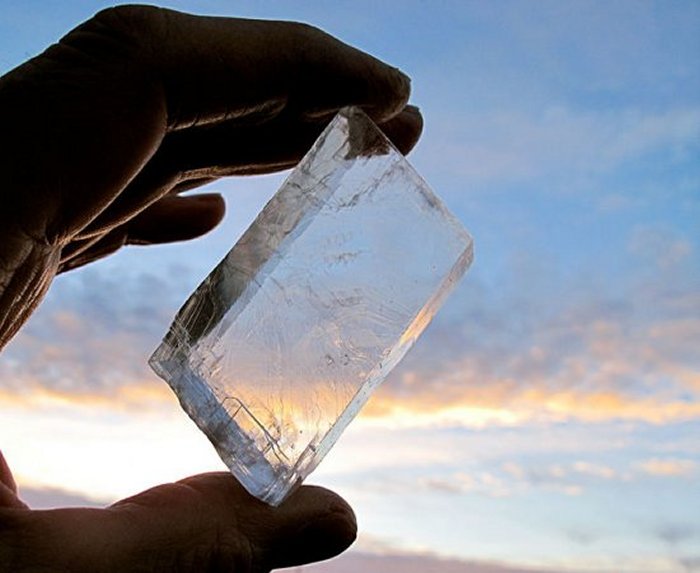Legendary Viking Sunstones Did Exist: Viking Sagas Were More Truthful Than We Realized
A. Sutherland - AncientPages.com - Modern navigation instruments were unknown to Vikings, and they relied on own senses, celestial bodies, birds, swells, whales, chants, and rhymes to navigate the seas and discover new land.
During the Viking Age, people started to categorise ships according to their functions. There were two types. One was primarily suitable for transporting armed men. The other was suitable for transporting cargo. Pictured here is the Viking Ship Museum’s freighter Ottar, which is of the type that was used for navigating the North Atlantic islands. (Photo: the Viking Ship Museum in Roskilde via Science Nordic
They even took advantage of the wind and the stars as clues to make their navigation easier.
Viking sagas handed down orally from generation to generation may have been more credible sources of this kind of navigation than we earlier realized. The success of the voyage depended on several factors.
In their study, researchers analyzed as many as one thousand conceivable “three-week-long Viking voyages along the latitude 60°21'55" N from Norway to Greenland with changing cloudiness at summer solstice and spring equinox.”
When the sun was hidden by clouds or thick fog, the navigators had to determine first the position of the invisible sun, and it was performed by means of skylight polarization and sunstone (e.g. calcite, cordierite, or tourmaline) crystals functioning as linear polarizers.
Despite this important study, Viking navigation from Norway to America in the northern latitudes still remains a mystery for physicists, historians, and archaeologists. Crystal "sunstones" could have helped Viking sailors to navigate even when clouds or fog hid the sun and hindered long-distance sea voyages. One ancient travelogue can be found in the medieval Norse manuscript ’Hauksbók’. Various landmarks like trees, buildings, islands, hills, and more were often given place names based on their special characteristics. These names helped the Vikings navigate their way to their destination.
It is not known whether the Vikings really used the method, but if they did, they could navigate their ships precisely and with success.
 This crystal found at the Alderney shipwreck. Image credit & copyright: Alderney Museum
This crystal found at the Alderney shipwreck. Image credit & copyright: Alderney Museum
However, the study further notes that nobody really knows what the Vikings' navigation practices really were, especially during critical weather conditions on the high seas like storms, heavy winds, ocean currents, or ships drifting during the night.
Since there were neither nautical charts nor any written descriptions back then, the Vikings’ travelogues consisted of narratives and rhymes.
An example of these travelogues can be found in the medieval Norse manuscript ’Hauksbók’.
"From Hernam [present-day Hennø near Bergen] in Norway, head due west towards Hvarf in Greenland, and you will have sailed north of Hjaltland [the Shetland Islands}, so that you just glimpse it in clear weather, but south of the Faroe Islands, so that the sea [the horizon] is right in between the distant mountains, and thus also south of Iceland.”
So, they sailed from Hennø in Norway, heading due west towards Greenland, between Shetland and the Faroes and south of Iceland.
It is known that also Polaris - “Leiðarstjarna” the “guiding star” was as used for navigation.
To guide them across the North Atlantic, the Viking navigators also used their senses and relied on them. Anton Englert, who researches Viking Age seafaring at the Viking Ship Museum in Roskilde, Denmark, pointed out that these experienced seafarers were able to hear how close they were to land when it was too foggy to see.
In silence, they carefully listened to the screeching of birds and the sound of waves breaking on the shore. The Vikings could also extract a lot of information just from a sea breeze. Another kind of help for the Viking mariner was a plumb bob used to assess the depth of the water. Such a tiny sample from the seabed was touched and tasted to determine if fresh water flowed from land into the sea water.
Crystals of calcite, like this one, may have been the “sunstones” of Viking legend that enabled these seafarers to successfully navigate lengthy voyages. Credit: Public Domain
A thirteenth-century manuscript called St Olaf’s Saga, informs that the Icelandic hero Sigurd tells King Olaf II Haraldsson of Norway where the sun is on a cloudy day. Olaf checks Sigurd's claim using a mysterious sunstone: 'Olaf grabbed a Sunstone, looked at the sky, and saw from where the light came, from which he guessed the position of the invisible Sun...'.
A special crystal discovered with the wreckage of the Alderney, an Elizabethan warship that sank near the Channel Islands in 1592, suggests legendary Viking sunstones did exist in reality.
The sunstones (like the one discovered at the Alderney shipwreck) could have been held up toward the center of the sky, allowing sunlight to hit it and get polarized and broken into an "ordinary" and an "extraordinary" beam. On a clear not cloudy day, they could have rotated the crystal until the pair of beams lined up. By noting where the sun was when this happened, navigators could make a reference point to use even when the Sun was obscured by clouds or twilight.
If the crystal is held east-west, the double image becomes a single image and thus allows a sailor to locate the Sun.
According to the study published in the journal Proceedings of the Royal Society, "such a crystal immersed in seawater plays a crucial role by limiting the solubility, strengthening the mechanical properties of the calcite, while the sand abrasion alters the crystal by inducing roughness of its surface.
Although both phenomena have reduced the transparency of the Alderney calcite crystal, researchers demonstrated that Alderney-like crystals could really have been used as an accurate optical sun compass as an aid to ancient navigation when the Sun was hidden by clouds or below the horizon.
To avoid the possibility of large magnetic errors not understood before 1600, an optical compass could have helped provide the sailors with an absolute reference.
An Alderney-like crystal permits the observer to follow the azimuth of the Sun, far below the horizon," the research team writes in the science paper. It is doubtful archaeologists will ever uncover a complete crystal in a Viking site because Vikings preferred to commit their dead to funeral pyres, cremating them and their grave goods.
One of the reasons why the existence of sunstones has long been disputed is because they are mentioned in the saga of Saint Olaf, a tale with many magical elements. However, the latest discovery offers evidence that so-called magical Viking sunstones really existed.
Written by – A. Sutherland - AncientPages.com Senior Staff Writer
Updated on Sep 15, 2023
Copyright © AncientPages.com All rights reserved. This material may not be published, broadcast, rewritten or redistributed in whole or part without thexpress written permission of AncientPages.com
Expand for referencesReferences:
Karlsen, Leif K.,Secrets of the Viking Navigators
Dénes Száz and Gábor Horváth, “Success of sky-polarimetric Viking navigation revealing the chance Viking sailors could reach Greenland from Norway”
Dénes Száz and Gábor Horváth, Success of sky-polarimetric Viking navigation: revealing the chance Viking sailors could reach Greenland from Norway
Burch D. Emergency Navigation
More From Ancient Pages
-
 In Ancient Mesopotamia, Sex Among The Gods Shook Heaven And Earth
Featured Stories | Oct 8, 2022
In Ancient Mesopotamia, Sex Among The Gods Shook Heaven And Earth
Featured Stories | Oct 8, 2022 -
 What Is The Meaning Of Ancient Hand Signs We Still Use Today?
Featured Stories | Apr 23, 2025
What Is The Meaning Of Ancient Hand Signs We Still Use Today?
Featured Stories | Apr 23, 2025 -
 Puzzling Ancient Artifacts And Skeleton Discovered In Iowa – Evidence Of A Lost Ancient Civilization?
Ancient Mysteries | Jun 16, 2018
Puzzling Ancient Artifacts And Skeleton Discovered In Iowa – Evidence Of A Lost Ancient Civilization?
Ancient Mysteries | Jun 16, 2018 -
 Medusa – Cursed By Athena And Killed By Perseus
Featured Stories | Jul 30, 2018
Medusa – Cursed By Athena And Killed By Perseus
Featured Stories | Jul 30, 2018 -
 Blame The Neanderthals For Your Lower Back Pain – Scientists Say
Archaeology | Mar 8, 2022
Blame The Neanderthals For Your Lower Back Pain – Scientists Say
Archaeology | Mar 8, 2022 -
 Neolithic Monuments, Prehistoric Pits And Anglo-Saxon Cemetery Unearthed In England
Archaeology | Apr 19, 2016
Neolithic Monuments, Prehistoric Pits And Anglo-Saxon Cemetery Unearthed In England
Archaeology | Apr 19, 2016 -
 Ancient Intriguing Sao People: “Men From Another Time” – One Of The Oldest Civilizations Of Central Africa
Featured Stories | Sep 28, 2015
Ancient Intriguing Sao People: “Men From Another Time” – One Of The Oldest Civilizations Of Central Africa
Featured Stories | Sep 28, 2015 -
 Submerged Ancient Bridge Found In Genovesa Cave Reveals Humans Settled In Mediterranean Much Earlier Than Previously Thought
Archaeology | Sep 2, 2024
Submerged Ancient Bridge Found In Genovesa Cave Reveals Humans Settled In Mediterranean Much Earlier Than Previously Thought
Archaeology | Sep 2, 2024 -
 On This Day In History: Antarctic Explorer Lawrence “Titus” Oates Born – On Mar 17, 1880
News | Mar 17, 2017
On This Day In History: Antarctic Explorer Lawrence “Titus” Oates Born – On Mar 17, 1880
News | Mar 17, 2017 -
 3,000 Years Ago Human Activity Destroyed Vegetation And Irreparably Damaged The Timna Valley Environment
Archaeology | Sep 23, 2022
3,000 Years Ago Human Activity Destroyed Vegetation And Irreparably Damaged The Timna Valley Environment
Archaeology | Sep 23, 2022 -
 3,000-Year-Old Graves With Some Oldest Burial Sites Discovered in Central Norway
Archaeology | Dec 8, 2017
3,000-Year-Old Graves With Some Oldest Burial Sites Discovered in Central Norway
Archaeology | Dec 8, 2017 -
 Neanderthals Buried Their Dead And Developed Spirituals Beliefs – Did Neanderthals Practice Religion?
Featured Stories | Dec 28, 2016
Neanderthals Buried Their Dead And Developed Spirituals Beliefs – Did Neanderthals Practice Religion?
Featured Stories | Dec 28, 2016 -
 Amazing Discovery: Great Pyramid Of Giza And Its Chambers Concentrate Electromagnetic Energy
Archaeology | Jul 31, 2018
Amazing Discovery: Great Pyramid Of Giza And Its Chambers Concentrate Electromagnetic Energy
Archaeology | Jul 31, 2018 -
 Who Were The Satraps Of The Achaemenid Empire?
Featured Stories | Aug 28, 2021
Who Were The Satraps Of The Achaemenid Empire?
Featured Stories | Aug 28, 2021 -
 Lost City Of Irisagrig Comes To Life In Ancient Stolen Tablets
Archaeology | Jun 5, 2018
Lost City Of Irisagrig Comes To Life In Ancient Stolen Tablets
Archaeology | Jun 5, 2018 -
 Was The Discovery Of Biblical Abel’s Giant Grave In Syria Covered-Up?
Ancient Mysteries | Oct 28, 2014
Was The Discovery Of Biblical Abel’s Giant Grave In Syria Covered-Up?
Ancient Mysteries | Oct 28, 2014 -
 Surprising Discovery Of Ancient Roman Salt Factory In England
Archaeology | Oct 8, 2020
Surprising Discovery Of Ancient Roman Salt Factory In England
Archaeology | Oct 8, 2020 -
 Kukulkan (Quetzalcoatl): Feathered Serpent And Mighty Snake God
Featured Stories | Feb 7, 2017
Kukulkan (Quetzalcoatl): Feathered Serpent And Mighty Snake God
Featured Stories | Feb 7, 2017 -
 Unique Glimpse Into The Secrets Of Mysterious Ancient Egyptian Manuscripts And Sacred Tablets Deliberately Hidden From The Outside World
Featured Stories | Dec 29, 2024
Unique Glimpse Into The Secrets Of Mysterious Ancient Egyptian Manuscripts And Sacred Tablets Deliberately Hidden From The Outside World
Featured Stories | Dec 29, 2024 -
 Well-Preserved Settlement Dated To 2,400 BC Unearthed At Tell Edfu, Egypt
Archaeology | Feb 8, 2018
Well-Preserved Settlement Dated To 2,400 BC Unearthed At Tell Edfu, Egypt
Archaeology | Feb 8, 2018


